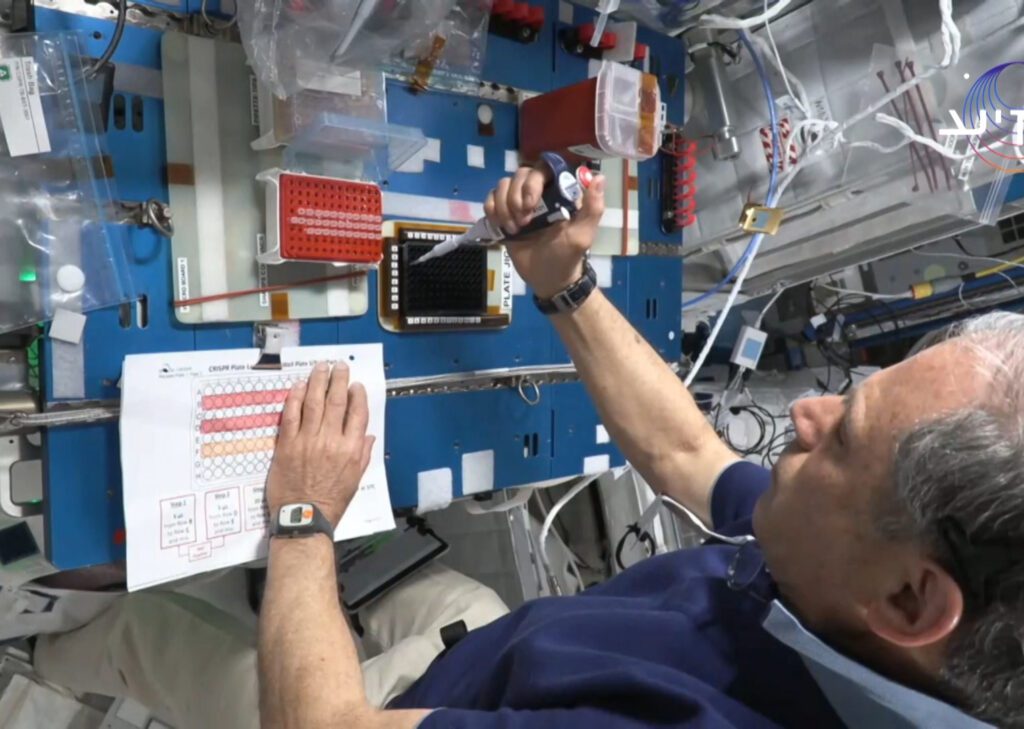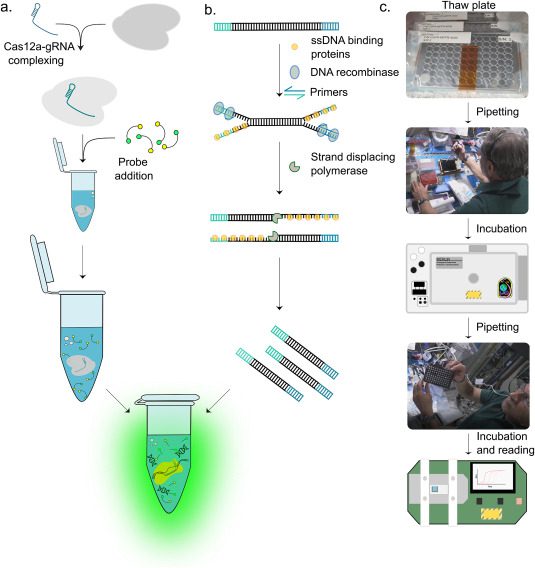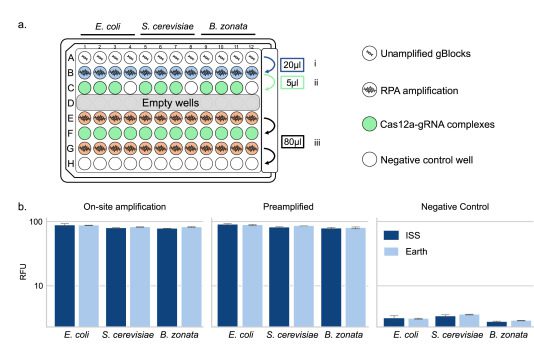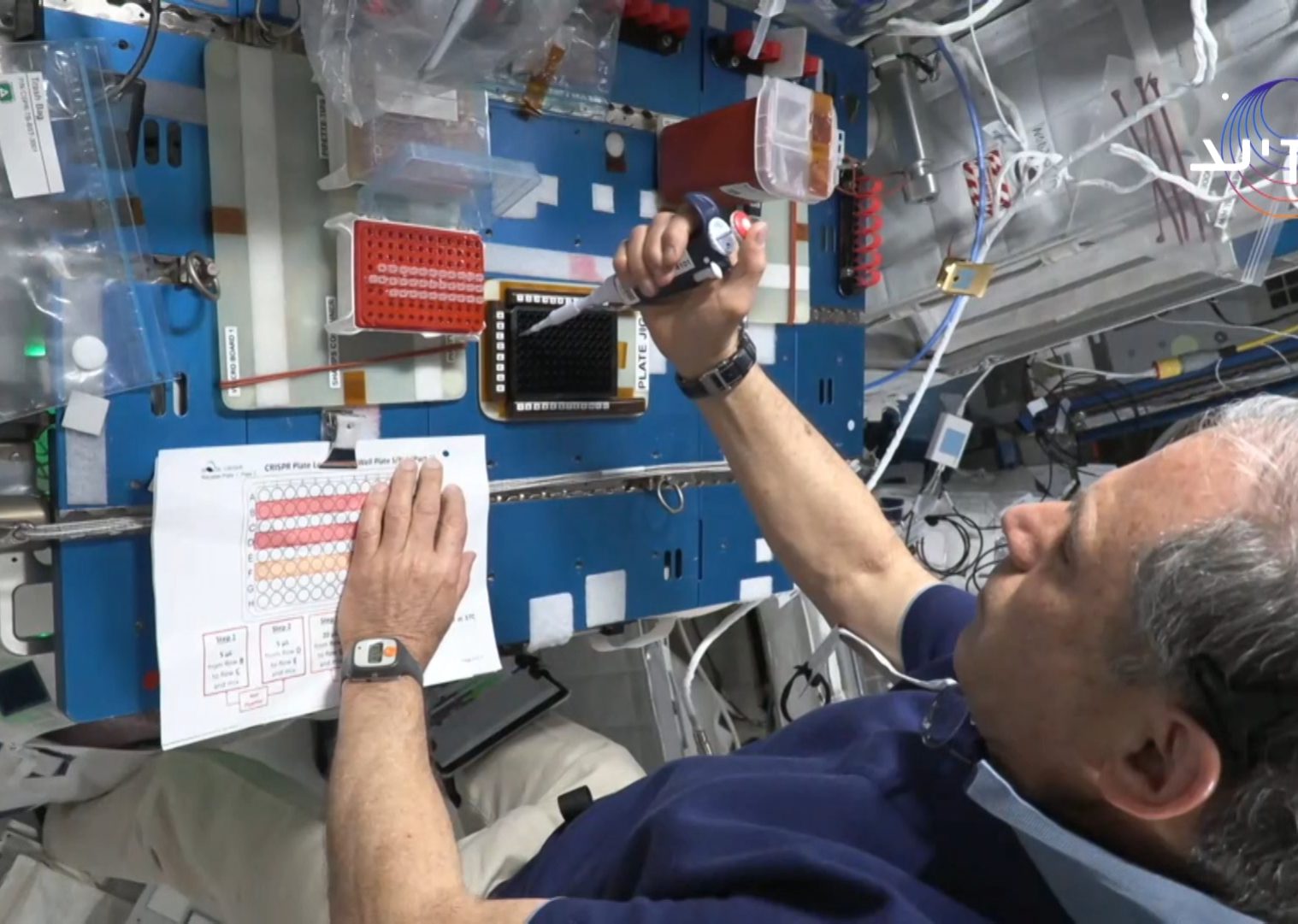
Eytan Stibbe on the International Space Station
(Photo: Rakia Mission)

Detection method overview and protocol workflow

Plate A, testing RPA and Cas12a activity in microgravity

Gur Pines, researcher at the Agricultural Research Organization, Israel



Bactrocera zonata as space invader: Gene detecion in microgravity
24 August 2023
A team of Israeli researchers has tested gene detecting in space. Among other samples, they used Bactrocera zonata.
While the REACT project is primarily concerned with protecting agriculture from invasive, harmful fruit flies, there are already thoughts about how to protect the cultivation of plant organisms in space in the future, namely during long-term manned space missions. One of the fruit fly species targeted by REACT has therefore already been part of a series of tests on the International Space Station (ISS).
In April 2022, the first private orbital space flight took off from Cape Canaveral to the ISS. Israeli astronaut Eytan Stibbe embarked on this flight to complete the “Rakia” mission, which included dozens of scientific experiments. As part of this mission, Gur Pines and a team of scientists tested the collateral activity of Cas12a and RPA amplification in microgravity. The series of tests targeted three organisms from different branches of the tree of life: Escherichia coli, Saccharomyces cerevisiae, and Bactrocera zonata.
The aim of the tests in microgravity was to find out, if Cas12a genetic detection could contribute to medical and hygienic safety during manned space missions in the future. Gur Pines, who in REACT works on developing rapid tests to identify fruit flies at the larval stage, explains why the fruit fly Bactrocera zonata was one of the organisms tested on board the international space station and what scientific insights were gained from the space mission.
How did Bz qualify as a valuable organism to be tested during the mission?
To test the technology’s specificity under microgravity conditions, my collaborator from Tel Aviv University, Dr. David Burstein, and I selected to detect three organisms representing different branches of the tree of life, with potential relevance to future space missions. The first two were microorganisms, namely E. coli (bacteria) and S. cerevisiae (yeast), representing potential pathogens threatening the astronauts’ health. We selected the third organism to represent an agricultural pest since longer missions will probably require space farming at some capacity. While we hope that earth-derived pests will never leave Earth, with space travel becoming more and more accessible, we cannot rule this option from ever happening, unfortunately. We have been working with B. zonata for a while, so it was a natural choice.
What was the greatest challenge to overcome in preparing the testing on ISS?
Preparing for such an experiment had many challenges. This was our first (and hopefully not the last) experiment sent to the International Space Station. The time we had from the announcement that our experiment was selected to be performed onboard the ISS until the expected launch was very short, and it was unclear whether we would be prepared in time. To be honest, we did not know what we got ourselves into. We had to complete the experiment’s protocol and simplify it as much as possible while considering restrictions imposed by microgravity and NASA. For example, our initial design was to have all the reagents in powder form to simplify shipping, and the first step would be to rehydrate the different reagents. But it soon occurred to us that that would not be possible since the powder would float away when the containers were opened, so eventually, the experiment was shipped as frozen liquid. This is also the place to acknowledge BioServe Space Technologies from Boulder, Colorado, who helped us with so many things, including the experimental design, protocol simplification, and Eytans training. Also, the experiment was part of the first-ever commercial flight to the ISS, which required a lot of coordination with many different private, commercial, and governmental entities since everything was done for the first time.
How did you prepare astronaut Eytan Stibbe for doing the experiments?
Within the short time to launch, we had to schedule training sessions for our astronaut, Mr. Eytan Stibbe, for whom this was one of 44 scientific experiments he performed in various disciplines. Eytan is not a trained biologist, and we had to start with the basics. Eytan took the training very seriously and trained until he felt confident that he could conduct the experiment successfully. After all, we had only one shot at this. The initial training took place in Israel and was led by Dr. Dan Alon, then a Ph.D. student, who, together with Dr. Karin Mittleman, did all the required experimental preparations. The second training phase was done in the US by BioServe personnel who also helped us adapt our protocol and who accompanied him during the experiment remotely.
When did you learn about the results of the experiments in space? Was it only after the completion of the mission, or were results sent back to Earth even during the mission?
We had the privilege to witness the experiment being conducted in real-time from the Rakia Mission Control room in Tel Aviv. Due to the experiment’s complexity, it was done in two different sessions, the first verifying the specificity and the second testing the sensitivity. Witnessing our experiment unfold was very exciting, especially since I brought my kids, and I got to see their enthusiasm during the process. A few hours after the experiment was concluded, the results were transmitted to BioServe, who transferred them to us. We were super excited! Then, Dan and Karin peered into the data, and within a few minutes, we knew that the experiment worked.
The paper recently published based on the tests outlines how future space missions could benefit from CRISPR-based diagnostics? However, did the experiments also show results that have implications for the implementation of testing methods on Earth?
CRISPR-based detection is a fantastic technology. It is simple to perform, very specific, and also very sensitive. With discoveries and applications being made regularly, I believe this technology will be expanded in ways we can’t imagine. Our microgravity experiment signifies how universal and robust this system is and its potential to be performed under extreme conditions.
Were there any learnings from the experiment, that REACT could draw upon, maybe for example, in the design of simple testing tools or testing kits?
Our microgravity experiment helped to establish these genetic-based diagnostics as a universal platform. While other methods exist, we hope to further develop and simplify this CRISPR-based approach to allow the detection of everything that has DNA or RNA, let it be a virus, pathogenic bacterium, or an agricultural pest.
This interview was conducted by Thomas Stollenwerk of Oikoplus GmbH, Vienna in August 2023 for the REACT project.
Dan Mark Alon, Karin Mittelman, Eytan Stibbe, Stefanie Countryman, Louis Stodieck, Shankini Doraisingam, Dylan Mikeala Leal Martin, Eliran Raphael Hamo, Gur Pines, David Burstein, CRISPR-based genetic diagnostics in microgravity, Biosensors and Bioelectronics,
Volume 237, 2023, 115479, ISSN 0956-5663, https://doi.org/10.1016/j.bios.2023.115479
